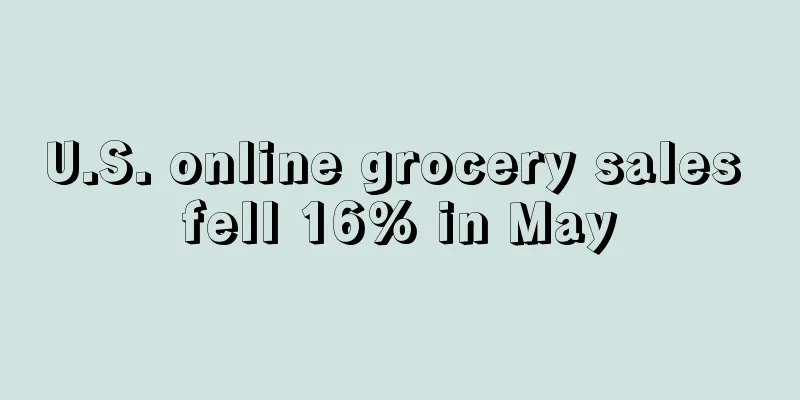U.S. online grocery sales fell 16% in May

|
The latest e-commerce report from Brick Meets Click and Mercatus shows that total U.S. grocery e-commerce sales in May were $7 billion, down 16% from the same period last year.
The weighted average order value for the month fell 7% year-over-year , with delivery and pickup spending per order falling 14% to $77, while the value of home delivery orders rose 4% to $50.
The study found that as cross-shopping increases, consumers’ expectations of grocery shopping are being influenced by comparable services from mass retailers. In May, 29% of online customers used both grocery and mass retail services, compared to 15% in August 2019.
David Bishop, partner at Brick Meets Click, said U.S. e-commerce sales in May were down sharply compared with the same period last year, when consumers ordered online en masse early in the coronavirus pandemic, making the 16% sales drop less dramatic.
He noted that online sales in the U.S. totaled $7 billion in May, 3.5 times the pre-pandemic level of $2 billion in August 2019, according to Brick Meets Click.
“May results show that the market has retained 70% of its incremental gains from the coronavirus-driven record high of $9.3 billion, indicating that the majority of the pandemic-driven gains remain in place,” Bishop said in the report’s statement.
Looking at the performance of e-commerce so far this year, sales have shown "volatility" as consumers get vaccinated and return to in-store shopping . Online sales in January and March both reached $9.3 billion, while May was the first month this year to see monthly online sales decline for two consecutive months, with a return rate down from $8.4 billion in April. (Image source: Brick Meets Click) Survey data shows that store-based e-commerce continues to lead home delivery services as shoppers turn to local grocery stores. Pickup remains the most popular channel, used by 55% of monthly active users, up 4 percentage points from May last year. Nearly 30% of active users only use the pickup function for e-commerce purchases, indicating that consumers prefer a more profitable service than delivery, and 17% of active users only use delivery services on a monthly basis.
In the early months of the pandemic, shoppers spread their spending across a range of home delivery services as local grocers faced capacity issues . That spending continued to contract, with home delivery share of active users falling 6 percentage points year-over-year and order share falling 8 percentage points.
While the sales volatility isn't surprising, Brick Meets Click reported that there are still signs that online grocery loyalty is weak amid growing competition. The repeat usage rate -- the likelihood that an active online user will use the same grocery service again in the next month -- was 53%, 4 percentage points lower than a year ago. It's also Brick Meets Click's lowest rate so far this year, down from a high of 62% in March. Online Shopping E-commerce USA |
<<: PayPal's new adjustment will increase seller fees
>>: Start harvesting? Wish adjusts the commission ratio of orders
Recommend
What is Kangu? Kangu Review, Features
Kangu is a logistics company in Latin America, wit...
What is Netcom Speed? Netcom Speed Review, Features
Netcom Logistics (Hong Kong Netcom Logistics Co.,...
What is OneSight Marketing Cloud? OneSight Marketing Cloud Review, Features
OneSight Marketing Cloud is a growth platform bas...
The public trademark "TWS" was maliciously registered, and some sellers' products have been removed from the shelves due to complaints!
Recently, a seller revealed that the three letter...
Actively responding to epidemic prevention policies, Shopee and Lazada accelerate delivery
Since the implementation of the policy directive ...
What is ラクマ? ラクマReview, Features
Rakuma (Akuma Fun Shopping) is a mobile flea marke...
Tens of thousands of infringing products have been seized, sellers should beware
Foreign countries attach great importance to the ...
Amazon India leads investment in beauty brand MyGlamm, marking its first investment in DTC consumer goods brands
According to foreign media reports, Amazon, Ascen...
A large number of teaching live broadcasts are now being copied and sold on short video platforms. Sellers: Report it
On Amazon, the phenomenon of copycat sales is alm...
What is 1DS? 1DS Review, Features
One E-commerce (Hong Kong One E-commerce E-commerc...
Facing the risk of closure? SHEIN makes an urgent response
In the United States, almost all news about SHEIN...
What is kat-vr? kat-vr Review, Features
kat-vr is an independent VR software and hardware ...
What is HYK-Express? HYK-Express Review, Features
HYK-Express was established in 2002. Its predeces...
Being cheated by the factory and the popular products failed! Cross-border sales staged a comeback against the wind
In recent years, the number of sellers on major c...
What is shimu? shimu Review, Features
shimu is a website focusing on furniture sales. A...









